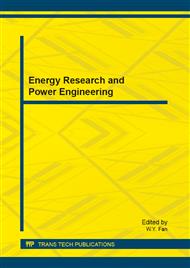[1]
Hao Jiming, China muat develop nitrogen oxides control strategy[J]. Science Times. 2008. 10.
Google Scholar
[2]
Zheng Weilong, Experimental and numerical research on low nitrogen oxide burners and its application[D]. National Central University (Taiwan). (2005).
Google Scholar
[3]
Sun Keqin, Zhong Qin, Thermal power plant flue gas denitrification technology and its application [M]. Beijing: Chemical Industry Press. (2007).
Google Scholar
[4]
Wang Xuedong, Study on Nitrogen oxides emission characteristics of coal-fired boilers and flue gas denitration catalyst[D]. Shandong University. (2009).
Google Scholar
[5]
Kinga Skalska, Jacek S. Miller, et al. Trends in NOx abatement: A review[J]. Science of the Total Environment. 2010 (408): 3976–3989.
DOI: 10.1016/j.scitotenv.2010.06.001
Google Scholar
[6]
Khandoker A. H., Mohammad N. M. J., Azeman M. Application of selective non-catalytic reduction of NOx in small-scale combustion systems[J]. Atmospheric Environment. 2004(38) 6823–6828.
DOI: 10.1016/j.atmosenv.2004.09.012
Google Scholar
[7]
Kelemen S R, Gorbaty M L, Kwiatek P J, et al. Nitrogen Transformations in Coal during Pyrolysis [J]. Energy Fuels, 1998, 12(1): 159−173.
DOI: 10.1021/ef9701246
Google Scholar
[8]
Hulgaard T, Dam-Johansen K. Homogeneous Nitrous Oxide Formation and Destruction under Combustion Conditions [J]. AIChE J., 1993, 39: 1342−1354.
DOI: 10.1002/aic.690390811
Google Scholar
[9]
Li-Gang Zheng, Hao Zhou, et al. A comparative study of optimization algorithms for low NOx combustion modification at a coal-fired utility boiler[J]. Expert Systems with Applications: An International Journal. 2009. 36(2): 2780-2793.
DOI: 10.1016/j.eswa.2008.01.088
Google Scholar
[10]
DOE/NETL-2001/1143. Evaluation of Gas Reburning and Low-NOx Burners on a Wall-Fired Boiler[J]. A DOE Assessment. website: www. netl. doe. gov.
DOI: 10.2172/783803
Google Scholar
[11]
Yoichiro Ohkubo. Low-NOx Combustion Technology[J]. R&D Review of Toyota CRDL Vol. 41(1): 12-23.
Google Scholar
[12]
Wang Qingcheng, Luo Yonghao, Influence of Secondary Air on Combustion Characteristics of Grate-Fired Furnaces[J], Journal of power engineering. 2006. 26(6): 780-783.
Google Scholar
[13]
Hao Xuemei, Study on Two-stage Air Over-fire Technology of Staged-air Combustion Technology[J]. Clean coal technology. 2007. 13(2): 70-72.
Google Scholar
[14]
Feng Yanlei, Luo Yonghao, Experimental Research on Reburning Technology to Reduce NOx Emissions in Stoker Boiler[J]. Journal of power engineering. 2004. 24(1): 29-32.
Google Scholar
[15]
Chang Bing, Experimental study on influence of wind distribution on combustion characteristics of the grate-fired furnaces[D]. Shanghai Jiao Tong University, (2007).
Google Scholar
[16]
Jia Jinghua, Dong Li, Numerical Simulation of Low NOx Emission Characteristics in a Pyrolysis-Combustion Chain Grate Boiler[J]. The Chinese journal of process engineering. 2010. 10, (5): 842-848.
Google Scholar


